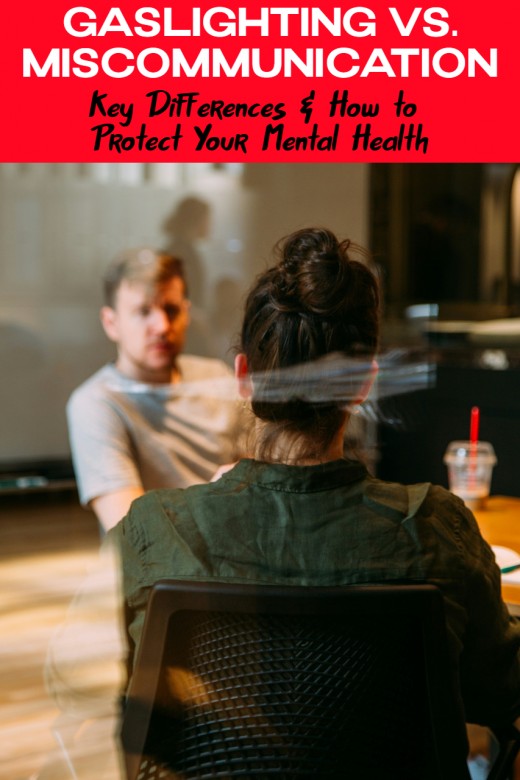Gaslighting vs Miscommunication: How to Recognize Manipulation vs Honest Mistakes

Gaslighting vs. Miscommunication: How to Spot the Difference and Protect Your Mental Health
It often starts quietly—with a missed deadline, a forgotten promise, or a disagreement over what was said. You leave the exchange unsettled, replaying it in your head. Did I mishear? Did I drop the ball? Or is something more manipulative at play—an attempt to make me doubt my own memory and perception?1
This internal tug-of-war is more than just confusion—it’s the crossroads between miscommunication and gaslighting. One is a frustrating but natural part of human interaction. The other is a calculated form of psychological manipulation that can break down trust, confidence, and even career stability.2
Understanding the difference isn’t merely helpful—it’s essential. It allows you to protect your mental health, respond with clarity, and make informed decisions about whom to trust and how to move forward.3 To help you discern the difference in real life, we’ll define both gaslighting and miscommunication, offer practical examples and signs of each, and share grounded strategies for how to respond.

What Is Gaslighting?
Gaslighting is a form of psychological manipulation that causes someone to question their own reality, memory, or perception.4 It often involves subtle distortions, denials, or blame-shifting that erode a person’s confidence and sense of truth.5 Over time, this can lead to heightened anxiety, chronic self-doubt, depression, and a loss of trust in one’s own judgment.6
While gaslighting is most commonly discussed in the context of personal relationships, it can also appear in workplaces, families, and organizations.7 It’s especially prevalent in medical settings, where patients—particularly women and marginalized groups—report being dismissed or disbelieved by healthcare providers, often leading to delayed diagnoses and lasting harm.8

Examples of Gaslighting
-
You say: “You told me I wasn’t qualified.”
Gaslighter responds: “I never said that. You’re twisting my words again.”
-
You say: “You promised you’d be there.”
Gaslighter responds: “I never promised anything. You must have misunderstood.”
-
You say: “It hurt when you joked about my anxiety.”
Gaslighter responds: “There you go again being overly sensitive. I was just trying to lighten the mood.”
-
You say: “I felt dismissed when you brushed off my concern.”
Gaslighter responds: “You always feel dismissed. Maybe the problem is how you interpret things.”
-
You say: “I’ve been in pain for weeks and no one’s taken me seriously.” Gaslighter responds: “You’re probably just stressed. Let’s not jump to conclusions.”
Common Signs of Gaslighting
-
You feel confused or “off” after conversations
-
Your emotions are dismissed or mocked
-
They deny things you clearly remember
-
You begin to doubt your own judgment
-
You feel increasingly dependent on their version of events

What Is Miscommunication?
Confusing interactions aren’t always manipulation. Knowing how to spot miscommunication is just as crucial as identifying gaslighting.
Miscommunication is a breakdown in understanding—often unintentional—where both parties may be trying to connect but end up missing each other’s meaning.9 Although frustrating, it doesn’t carry the same intent to destabilize or control. It typically stems from differences in language, tone, timing, or emotional context.
While miscommunication can cause hurt, it doesn’t involve manipulation or reality distortion. It’s part of everyday life: people mishear, misremember, or interpret words differently. No one is lying or seeking harm—it’s simply the messy nature of human interaction. Research shows miscommunication is one of the leading causes of conflict, but also one of the most solvable.10
Examples of Miscommunication
-
You say: “I felt dismissed when you didn’t respond.”
They reply: “I thought you were busy, and I didn’t want to bother you.”
-
You say: “It felt like you were brushing me off.”
They reply: “I was trying to keep things light; I didn’t realize my message sounded dismissive.”
-
You say: “I thought we agreed I would lead the presentation.”
They reply: “I assumed you wanted me to take the lead since you didn’t follow up.”
-
You say: “I felt left out of the decision.”
They reply: “I thought you were looped in. I didn’t realize you hadn’t seen the update.”
-
You say: “I thought you were upset with me.”
They reply: “I was quiet because I was overwhelmed—not because I was angry at you.”

Common Signs of Miscommunication:
-
Both parties feel misunderstood
-
Clarification leads to resolution
-
There’s no pattern of control or denial
-
Emotions may run high, but reality isn’t rewritten

Gaslighting vs. Miscommunication: What to Ask Yourself
Words or actions that don’t sit right can leave you feeling unsettled. While gaslighting and miscommunication may look similar on the surface, their intent and emotional impact are very different.
Before jumping to conclusions, consider a momentary pause to reflect. Asking a few key questions isn’t about blame but rather clarifying what you’re experiencing and deciding what kind of response or support will help.
Questions to ask yourself when things feel off:
- Is this a one-time misunderstanding or part of a pattern in your relationship?
-
Do I feel increasingly confused, ashamed, or unsure of myself?
-
Does the other person take accountability for their role, or always shift blame?
-
Am I being encouraged to trust my own experience—or taught to doubt it?
Key Differences Between Gaslighting and Miscommunication
Feature
| Gaslighting
| Miscommunication
|
|---|---|---|
Intent
| Deliberate manipulation or control
| Usually accidental or situational
|
Pattern
| Repeated, escalating over time
| Sporadic or context-dependent
|
Emotional Impact
| Erodes self-trust, causes confusion, anxiety, or shame
| Causes frustration or misunderstanding
|
Response to Clarification
| Denial, deflection, or blame-shifting
| Willingness to clarify or repair
|
Power Dynamics
| Often involves imbalance or exploitation
| Can occur between equals
|

Gaslighting vs Miscommunication: How to Respond
Strategies for Responding to Gaslighting
When gaslighting is at play, the priority isn’t to argue—it’s to get clear on what you know and protect your emotional well-being. The strategies below are meant to help you stay steady, respond with intention, and protect your sense of what really happened without getting pulled into confusion or conflict.
-
Name it internally: Recognize the tactic (without labeling it aloud)
-
Disengage calmly: Avoid defending or debating your reality
-
Reaffirm your memory: “I trust what I experienced, even if you see it differently11
-
Set boundaries: “I won’t continue this conversation if my experience is being denied”
-
Document interactions: Keep written records when possible12
-
Seek support: Talk to trusted friends, mentors, or therapists13
- Consider distancing yourself:If the behavior continues, you may need to step back from the relationship to protect your emotional well-being.
What to Say When You Suspect Gaslighting
Keep the conversation calm and respectful while staying true to yourself with statements such as one of the following:
-
“I’m confident in what I heard and how I experienced it, even if your memory is different.”
-
“I’ve reflected on that moment, and I still stand by how it felt to me.”
-
“I understand you may see it differently, but my experience of that conversation hasn’t changed.”
-
“Let’s agree that our recollections differ, but I’m going to move forward based on what I experienced.”
-
“Even if you didn’t mean it that way, that’s how it landed for me, and I need to honor that.”
-
“I won't debate my memory. I know what I experienced, and I’m choosing to trust myself.”
-
“We don’t have to agree on the details, but I won’t invalidate what I felt.”
-
“I won’t question myself over this. My experience matters, even if it’s uncomfortable to hear.”
What Not to Say
AVOID phrases that invite further distortion or self-doubt:
- “Maybe I’m just being dramatic …”
- “You’re probably right—I always get things wrong.”
- “I don’t know what’s real anymore.”
- “I must be overreacting.”
- “It’s probably all in my head.”
- “I guess I’m just too sensitive.”
- “I’m sure I misunderstood something.”

Strategies for Responding to Miscommunication
Understanding gaslighting vs. miscommunication helps you respond effectively in the moment. In cases of miscommunication, messages get crossed, intentions aren’t clear, and meaning slips through the cracks.
Your approach should shift according to the setting. At work, professionalism and clarity prevent repeated mix-ups and protect your reputation. In personal relationships, empathy and emotional nuance repair trust and maintain connection.
In the Workplace
-
Clarify expectations early
-
Use neutral, non-blaming language
-
Ask for feedback, not just answers
-
Stay emotionally steady
-
Follow up in writing
In Personal Relationships
- Lead with curiosity, not accusation
- Validate their perspective
- Use reflective listening
- Regulate your emotional response
- Repair quickly and gently
What to Say When You Suspect Miscommunication
- “I think we’re seeing this differently—can we slow down and clarify?”
- “I’m not accusing you. I just want to make sure we’re on the same page.”
- “Can we revisit what was said? I want to understand your intent.”
- “Let’s make sure we’re aligned so nothing gets lost in translation.”
- “I want to understand your perspective better—can you explain what you meant?”
- “I just want to check that I’m following you correctly.”
- “I’m not sure I understood fully—could you walk me through it?”
- “Let’s take a moment to make sure we both mean the same thing.”

Accused of Gaslighting? Here’s What to Say
Being accused of gaslighting someone can feel shocking if you didn’t intend harm. How you respond matters. The following statements help you stay open, accountable, and emotionally grounded.14 They can help you get repair the relationship and get the communication back on track.
- “I didn’t mean to dismiss you, but I can see how that landed. I want to understand what felt off.
- “I didn’t realize how much that hurt until you said it. I’m taking that seriously.”
- “I wasn’t trying to twist anything, but I hear you—and I want to understand better.”
- “I see now that I was more focused on defending myself than hearing you. That wasn’t fair.”
- “I care about your experience, even if I didn’t show it well. Let’s slow down and talk through it.”
- “I wasn’t trying to make you doubt yourself, but I can see how it came across that way. I’m sorry.”
- “I want to be someone you can feel safe being honest with—even when it’s hard for me to hear.”

Gaslighting vs Miscommunication: Why We Confuse the Two
Gaslighting often masquerades as miscommunication—especially in emotionally complex relationships. The confusion arises because both involve conflict, hurt feelings, and differing perspectives. But the core difference is intent. Miscommunication seeks resolution. Gaslighting seeks control.
Recognizing the difference between gaslighting and miscommunication isn’t just about labeling behavior—it’s about reclaiming your clarity, confidence, and emotional safety. When you learn to trust your instincts and spot manipulation early, you empower yourself to build healthier relationships and protect your peace.
References
1 Sweet, L. (2022). Gaslighting: A comprehensive guide to recognizing and recovering from emotional manipulation. HarperCollins.
2 Sarkis, S. (2018). Gaslighting: Recognize manipulative and emotionally abusive people—and break free. Da Capo Lifelong Books.
3 Durvasula, R. (2021). Should I stay or should I go? Surviving a narcissistic relationship. Post Hill Press.
4 Chang, H. Y., & Dubbin, L. A. (2020). Medical gaslighting: Gendered communication and the dismissal of patient pain. Journal of Health Communication, 25(6), 456–468. https://doi.org/10.1080/10810730.2020.1784725
5 Tannen, D. (2001). You just don’t understand: Women and men in conversation. Ballantine Books.
6 Cannon, J. (2025, March 11). 3 ways gaslighting impacts long-term mental health. Psychology Today. https://www.psychologytoday.com/us/blog/stress-fracture/202503/3-ways-gaslighting-impacts-long-term-mental-health
7 Goleman, D. (2006). Social intelligence: The new science of human relationships. Bantam Books.
8 McHugh, M., & Barlow, D. H. (2012). The science and practice of emotionally focused therapy. Guilford Press.
9 Gottman, J., & Silver, N. (2015). The seven principles for making marriage work. Harmony Books.
10 Lerner, H. (2017). Why won’t you apologize? Healing big betrayals and everyday hurts. Gallery Books.
11Morin, A. (2014). 13 things mentally strong people don’t do. HarperWave.
12 Forward, S. (1997). Emotional blackmail: When the people in your life use fear, obligation, and guilt to manipulate you. HarperCollins.
13 Brown, B. (2018). Dare to lead: Brave work. Tough conversations. Whole hearts. Random House.
14 Tatkin, S. (2016). Wired for love: How understanding your partner’s brain and attachment style can help you defuse conflict and build a secure relationship. New Harbinger Publications.
© 2025 Elaina Baker








